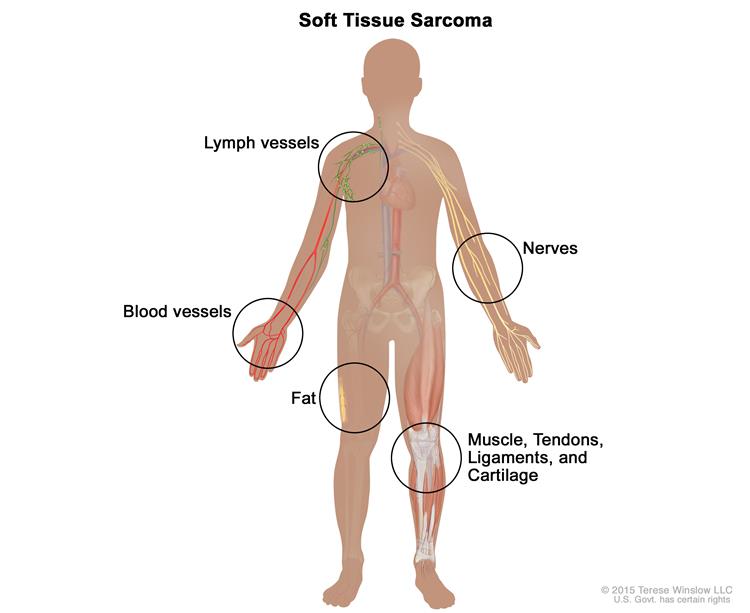Soft tissue sarcoma is a type of cancer that begins in the soft tissues of your body.
Soft tissues connect, support and surround other body structures. The soft tissues include muscle, fat, blood vessels, nerves, tendons and the lining of your joints.
Many types of soft tissue sarcoma exist. Some types are more likely to affect children, while others affect mostly adults.
Soft tissue sarcoma can occur anywhere in your body, but the most common types occur in the abdomen and in the arms and legs.
Symptoms
A soft tissue sarcoma may not cause any signs and symptoms in its early stages. As the tumor grows, it may cause:
· A noticeable lump or swelling
· Pain, if a tumor presses on nerves or muscles
Causes
In most cases, it’s not clear what causes soft tissue sarcoma.
In general, cancer occurs when cells develop errors (mutations) in their DNA. The errors make cells grow and divide out of control. The accumulating abnormal cells form a tumor that can grow to invade nearby structures and spread to other parts of the body.
The type of cell that develops the genetic mutation determines what type of soft tissue sarcoma you have. Some types of soft tissue sarcoma include:
· Alveolar soft part sarcoma
· Angiosarcoma
· Clear cell sarcoma
· Dermatofibrosarcoma protuberans
· Desmoplastic small round cell tumor
· Epithelioid hemangioendothelioma
· Epithelioid sarcoma
· Extrarenal rhabdoid tumor
· Fibrosarcoma
· Gastrointestinal stromal tumor
· Hemangiosarcoma
· Infantile fibrosarcoma
· Inflammatory myofibroblastic tumor
· Kaposi’s sarcoma
· Leiomyosarcoma
· Liposarcoma
· Lymphangiosarcoma
· Malignant fibrous histiocytoma
· Malignant peripheral nerve sheath tumor
· Myofibrosarcoma
· Myxofibrosarcoma
· Neurofibrosarcoma
· Perivascular epitheliod cell tumor (PEComa)
· Rhabdomyosarcoma
· Synovial sarcoma
· Undifferentiated, unclassified soft tissue sarcomas
Risk factors
Factors that may increase your risk of sarcoma include:
· Inherited syndromes. A risk of soft tissue sarcoma can be inherited from your parents. Genetic syndromes that increase your risk include hereditary retinoblastoma, Li-Fraumeni syndrome, familial adenomatous polyposis, neurofibromatosis, tuberous sclerosis and Werner syndrome.
· Chemical exposure. Being exposed to certain chemicals, such as herbicides, arsenic and dioxin, may increase the risk of soft tissue sarcomas.
· Radiation exposure. Previous radiation treatment for other cancers can increase the risk of soft tissue sarcomas.
Tests and diagnosis
Tests and procedures used to diagnose soft tissue sarcoma include:
· Imaging tests. Imaging tests, such as X-rays, computerized tomography (CT) scans, magnetic resonance imaging (MRI) and positron emission tomography (PET), may be used to evaluate the area of concern.
· Removing a sample of tissue for testing. Your doctor may perform a biopsy procedure to remove a sample of the suspected sarcoma for testing in a lab. To remove the sample, your doctor may use a long, thin needle. Sometimes a biopsy sample is removed during surgery.
If a soft tissue sarcoma is suspected, it’s often best to seek care at a medical center that sees many people with this type of cancer. Experienced doctors will select the best biopsy technique to ensure proper surgical treatment and planning.
In the lab, a doctor trained in analyzing body tissues (pathologist) examines the tissue sample for signs of cancer. The pathologist also analyzes the sample to understand the type of cancer and to determine whether the cancer is aggressive.
Treatments and drugs
It will depend on the size, type and location of your tumor.
Surgery
Surgery is a common treatment for soft tissue sarcoma. Surgery generally involves removing the cancer and some healthy tissue surrounding it.
When soft tissue sarcoma affects the arms and legs, it may be necessary to amputate the affected arm or leg. Doctors try their best to avoid amputation. One option to achieve this may be using chemotherapy and radiation to shrink the tumor before surgery, which increases the likelihood that an amputation will be unnecessary.
When soft tissue sarcoma spreads to another area of the body, it may be possible to remove the other tumor with surgery, as well.
Radiation therapy
Radiation therapy involves treating cancer with high-powered beams of energy, such as X-rays or protons.
Your doctor may suggest using radiation therapy before surgery to shrink a tumor to make it easier to remove with surgery. Radiation is also used after surgery to kill any cancer cells that remain.
Chemotherapy and radiation may be combined.
Chemotherapy
Chemotherapy is a drug treatment that uses chemicals to kill cancer cells. Chemotherapy can be administered by pill, through a vein (intravenously), or both methods may be used.
Some forms of soft tissue sarcoma respond better to chemotherapy than do others. For instance, chemotherapy is often used to treat rhabdomyosarcoma.
Targeted drug treatment
Targeted drugs block specific abnormal signals present in sarcoma cells that allow them to grow.


